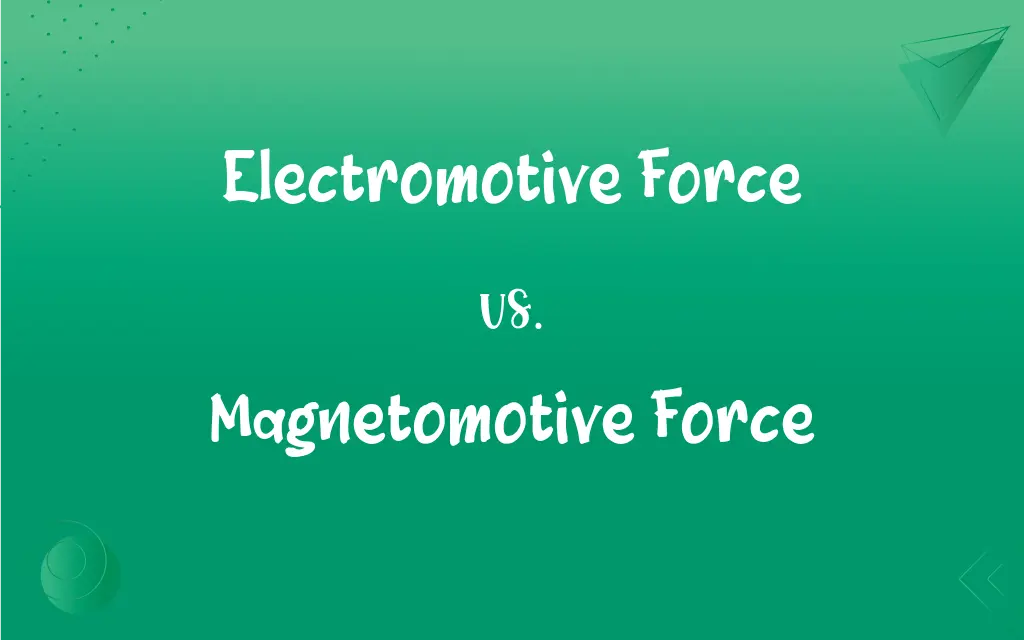Electromotive Force vs. Magnetomotive Force: What's the Difference?
Edited by Aimie Carlson || By Janet White || Published on February 29, 2024
Electromotive force (EMF) is the energy per unit charge generated by an electrical source, while magnetomotive force (MMF) is the driving force that sets up a magnetic field in a circuit.

Key Differences
Electromotive force (EMF) is a measure of the energy provided by an electrical source to move a charge through a circuit, often measured in volts. Magnetomotive force (MMF), on the other hand, is analogous to EMF but in magnetic circuits, measured in ampere-turns, and drives the magnetic flux through a magnetic circuit.
The EMF is generated in various ways, such as through chemical reactions in batteries or by electromagnetic induction in generators. MMF is generated by the flow of electric current through a coil of wire or by permanent magnets, creating a magnetic field.
EMF is a fundamental concept in electrical engineering and physics, relating to the generation and distribution of electrical power. MMF is key in understanding and designing magnetic circuits, like those in transformers and electric motors.
In a practical sense, EMF can be seen as the 'pressure' pushing electric charges through a circuit, and it is a source of potential energy. In contrast, MMF can be viewed as the 'pressure' that drives the magnetic field in a magnetic circuit.
EMF is essential in almost all electrical devices, from simple batteries to complex power generation systems. MMF is crucial in devices where magnetic fields are used, like in inductors, transformers, and magnetic storage devices.
ADVERTISEMENT
Comparison Chart
Definition
Energy per unit charge from an electrical source
Force driving magnetic flux through a magnetic circuit
Measurement Unit
Volts
Ampere-turns
Generation
Chemical reactions, electromagnetic induction
Electric current in coils, permanent magnets
Role
Pushes electrical charges through a circuit
Drives magnetic fields in magnetic circuits
Applications
Electrical power generation, batteries
Transformers, inductors, electric motors
ADVERTISEMENT
Electromotive Force and Magnetomotive Force Definitions
Electromotive Force
The voltage generated by an electrical source.
The EMF of a battery determines how much electrical energy it can deliver.
Magnetomotive Force
The force that drives magnetic flux in a magnetic circuit.
MMF in a transformer core is crucial for efficient energy transfer.
Electromotive Force
Central to the functioning of electrical devices and systems.
Solar panels convert light into EMF for electrical power.
Magnetomotive Force
Measured in ampere-turns, indicating strength of the magnetic field.
Increasing the current or the number of turns in a coil increases the MMF.
Electromotive Force
Often considered as the electrical 'pressure' in a circuit.
In a generator, motion in a magnetic field creates an EMF.
Magnetomotive Force
Depends on the current and the number of turns in the winding.
Higher MMF is achieved in inductors with more coil turns.
Electromotive Force
The driving force behind the movement of electrons in a circuit.
The EMF in a circuit determines the flow of current.
Magnetomotive Force
Essential in the design of magnetic circuits and devices.
The MMF is a key factor in the design of electric motor coils.
Electromotive Force
A measure of the electrical energy provided per charge.
A higher EMF implies a greater capacity to do work in an electrical circuit.
Magnetomotive Force
Analogous to electromotive force in electrical circuits.
MMF in an electromagnet can be controlled by adjusting the current.
FAQs
What unit is used to measure MMF?
MMF is measured in ampere-turns (At).
How is EMF measured?
EMF is measured in volts (V).
What is magnetomotive force?
Magnetomotive force (MMF) is the force that sets up and maintains a magnetic field in a circuit.
What creates MMF in a circuit?
MMF is created by electric current flowing through a coil or by permanent magnets.
What is electromotive force?
Electromotive force (EMF) is the voltage or energy per unit charge generated by an electrical source.
Is EMF a type of potential energy?
Yes, EMF is considered a form of potential energy in an electrical circuit.
How does MMF relate to transformers?
MMF is critical in transformers for transferring energy between coils via a magnetic field.
What factors affect the EMF of a battery?
The EMF of a battery is affected by its chemistry, construction, and temperature.
Can MMF be changed in a circuit?
Yes, MMF can be changed by altering the current or the number of turns in the coil.
Can MMF be negative?
MMF, like EMF, is a scalar quantity and does not have a negative value.
Can EMF be generated by a magnet?
Yes, EMF can be induced by moving a magnet near a coil of wire (electromagnetic induction).
What role does MMF play in electric motors?
MMF is essential in electric motors for creating the magnetic fields needed to produce motion.
How is EMF related to current?
EMF is the cause, and the electric current is the effect in a closed circuit.
What happens to EMF when a circuit is open?
When a circuit is open, EMF exists but does not produce a current.
Can MMF be used to calculate magnetic field strength?
Yes, MMF is used to calculate the magnetic field strength in magnetic circuits.
What is the source of EMF in solar cells?
In solar cells, EMF is generated by the photovoltaic effect.
Does EMF have a direction?
EMF has a direction, which determines the flow of current in a circuit.
Is MMF important in inductors?
Yes, MMF is crucial in inductors for establishing the magnetic field within the coil.
Does EMF vary with resistance?
The EMF remains constant, but the current varies with resistance in a circuit.
About Author
Written by
Janet WhiteJanet White has been an esteemed writer and blogger for Difference Wiki. Holding a Master's degree in Science and Medical Journalism from the prestigious Boston University, she has consistently demonstrated her expertise and passion for her field. When she's not immersed in her work, Janet relishes her time exercising, delving into a good book, and cherishing moments with friends and family.
Edited by
Aimie CarlsonAimie Carlson, holding a master's degree in English literature, is a fervent English language enthusiast. She lends her writing talents to Difference Wiki, a prominent website that specializes in comparisons, offering readers insightful analyses that both captivate and inform.































































